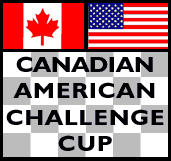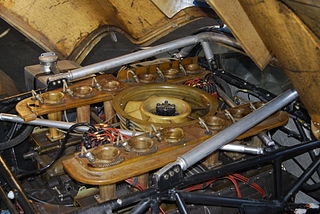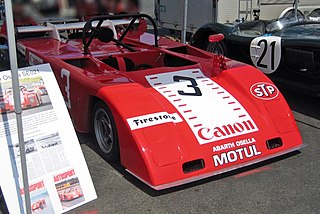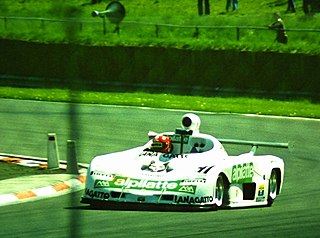
The Canadian-American Challenge Cup, or Can-Am, was an SCCA/CASC sports car racing series from 1966 to 1987.

The Chevron B23 is a Group 6 sports prototype race car, designed, developed and built by British manufacturer Chevron, in 1973. Over its racing career, spanning 12 years, it won a total of 12 races, scored 41 podium finishes, and clinched 2 pole positions. It was powered by a naturally-aspirated 3.0 L (180 cu in) Ford-Cosworth DFV Formula One engine, producing 398 hp (297 kW).

Porsche produced a series of normally-aspirated, and later an extremely powerful twin-turbocharged flat-twelve engine for their Porsche 917 sports prototype; between 1969 and 1973.
The Shadow Mk.II, is a purpose-built sports prototype race car, designed, developed and built by Shadow Racing Cars to Group 7 racing specifications, specifically to compete in the Can-Am racing series, in 1971. It was powered by a naturally aspirated, Chevrolet big-block engine, developing 740 hp (550 kW), and 655 lb⋅ft (888 N⋅m) of torque.
The AVS Shadow, also known as the Shadow Mk.I, is a purpose-built sports prototype race car, designed, developed and built by Shadow Racing Cars to Group 7 racing specifications, specifically to compete in the Can-Am racing series, in 1970. It was Shadow's first Can-Am car. Powered by a naturally aspirated, Chevrolet big-block engine, developing 740 hp (550 kW), and 655 lb⋅ft (888 N⋅m) of torque.

The Abarth-Osella 2000 Sport SE-021 is a mid-engined, Group 5, prototype race car, built by Osella to compete in the World Sportscar Championship sports car racing series in 1972, and for some races in 1973. The chassis itself was developed and developed by Osella, while the car itself was powered by a 2.0 L (120 cu in) Abarth four-cylinder engine, generating a healthy 265 hp (198 kW). Since the light and nimble chassis only weighed 530 kg (1,170 lb), this gave it an incredible power-to-weight ratio.

The Osella PA8 was a 2-liter, Group 6, sports car prototype, developed by Osella Squadra Corse in 1980, and used in sports car and Hillclimb races until 1988. It is powered by the naturally aspirated, 300 hp (220 kW), 2.0 L (120 cu in) BMW M12/7 engine, drives the rear wheels via a 5-speed Hewland LGA manual transmission.
The March 832 was a British open-wheel Formula 2 racing car, built by March Engineering in 1983. The car's best result in Formula 2 racing was third in the 1983 championship season with Beppe Gabbiani scoring 4 wins with Onyx Racing. After finding moderate success in open-wheel racing, it was later decided to convert the car to a closed-wheel sports prototype, for the revived Can-Am series, and compete in 1984. It was powered by the 2-liter BMW M12/7B engine. Kim Campbell successfully won the 2-liter Can-Am Championship that season, not scoring any wins, but managing to score 4 podiums, which was enough to clinch the championship.

The March 707 was a British Group 7 sports prototype racing car, built by March Engineering in 1970 for the Can-Am series. As with all other full-size Can-Am cars of the time, it used a large-displacement, mid-mounted, 457–502 cu in (7.49–8.23 L), naturally-aspirated, Chevrolet big-block V8 engine, generating between 680–800 hp (510–600 kW). It was driven by New Zealand racing driver, Chris Amon.

The March 717 was a British Group 7 sports prototype racing car, built by March Engineering in 1970 for the Can-Am series. As with all other full-size Can-Am cars of the time, it used a large-displacement, mid-mounted, 537 cu in (8.80 L), naturally-aspirated, Chevrolet big-block V8 engine, making 800 hp (600 kW). Like its predecessor, it was driven by legendary New Zealand racing driver, Chris Amon.

The Cooper T38, also known as the Cooper-Jaguar, is a lightweight sports car designed and developed by Cooper Cars for motor racing in 1955. It famously entered the infamous 1955 24 Hours of Le Mans, being driven by Peter Whitehead and Graham Whitehead, but retired after only 3–4 hours due to engine problems and an oil leak. It did not manage the score any wins in 1955, albeit with one podium at the end of the season. Between 1956 and 1962, and it managed to score a respectable 9 wins, and clinch 23 podium finishes; with six victories alone being achieved at the Silverstone and Goodwood Circuits. It is powered by the 250 hp (190 kW), 3.4-litre, XK engine, which was also used in many Jaguar sports cars.
The Cooper T25 is a sports car, designed, developed and built by Cooper Cars for sports car racing competition in 1953. It had humble beginnings; starting out in life as a Cooper-Bristol Mk.1, like its predecessor, the Cooper-Bristol T20/25. It found modest success, winning 18 out of the 80 races it entered between 1953 and 1955, including 2 class victories, and scored 33 podium finishes and one pole position over that same period of time. Like its predecessor, it was powered by the same 2-liter, 6-cylinder, Bristol engine.
The Cooper-MG is a series of two MG-powered sports cars that were designed, developed and built by Cooper Cars between 1950 and 1953. They were called the Cooper T14 and the Cooper T21, respectively. They actively competed in motor racing between 1950 and 1961. In that period, the MG-powered Coopers scored a total of 23 wins and 82 podium finishes between the two cars, and 2 pole positions. They were both power by the 1,250–1,500 cc (76–92 cu in) MG XPAG engine.
The Shadow DN12 was a Formula One car used by the Shadow team for the 1980 season, and was their last Formula One car chassis and entry. It was driven by Geoff Lees, and David Kennedy. It was powered by the commonly used 3.0 L (180 cu in) Cosworth DFV V8 engine. It only entered three races, making its debut at the 1980 Belgian Grand Prix. At the French Grnad Prix that year, both drivers, Geoff Lees and David Kennedy failed to qualify, after which Shadow retired from Formula One permanently.
The Toleman TG280 is an open-wheel ground effect Formula 2 racing car, developed and made by Toleman for the European Formula Two Championship, in 1980. It was designed by South African designer and engineer Rory Byrne. It successfully won and completely dominated the European F2 Championship in 1980, with Brian Henton and Derek Warwick finishing 1st and 2nd in the championship standings. It was powered by the 305 hp (227 kW) Hart 420R 2.0 L (120 cu in) four-cylinder engine, which droves the rear wheels via a Hewland F.T.200 5-speed manual transmission. After Formula 2 racing, it was later converted into a Can-Am-style prototype, and used in the European-based Interserie series.

The March 85G was a mid-engined IMSA racing sports prototype, designed and developed by March Engineering in 1984 and used in sports car racing until 1988.

The McLaren M22 is an open-wheel race car, designed and developed by McLaren, to compete in Formula 5000 racing in 1972. Like it predecessors, The McLaren M22 was manufactured in large numbers. Built close to the weight limit, it was very light and was powered by a 500+ hp Chevrolet V8 engine. The cars were not actually manufactured by McLaren itself, but by the British racing car manufacturer Trojan, as with previous models. This would turn out to be the last Trojan-built McLaren F5000 car.
The McKee Mk.10, also designated as the McKee Mk.X, is a special purpose-built American sports prototype race car, designed, developed, and built to Group 7 specifications, and competed in the Can-Am series, between 1968 and 1970. It was powered by both an Oldsmobile V8, and a Chevrolet small-block engine.
The March 82G is a IMSA GTP/Group C sports prototype race car, designed, developed and built by British manufacturer and constructor March Engineering, for sports car racing, in 1982. It competed in motor racing between 1982 and 1986, but only scored 1 race win, 8 podium finishes, and 2 pole positions. It was powered by a naturally-aspirated 620 hp (460 kW) 5.7 L (350 cu in) Chevrolet V8 engine.
The Lola T220, and its evolution, the Lola T222, are Group 7 sports prototype race cars, designed, developed, and built by the British manufacturer and constructor Lola, to compete in the Can-Am championship from the 1971 season. It also took part in the European Interserie championship.









